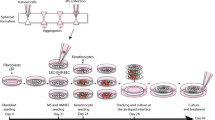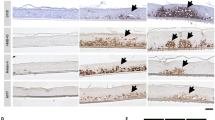Abstract
Cutaneous malignant melanomas represent an important clinical problem because they are highly invasive, they can metastasize to distant sites and are typically resistant to available therapy. The precise molecular determinants responsible for melanoma progression and chemo-resistance are not yet known, in part due to lack of pertinent experimental models that mimic human melanoma progression. Accordingly, we developed a complex human microvascularized reconstructed skin substitute in which the organized three-dimensional (3D) architecture of the native skin is reproduced. Human melanoma cell lines derived from primary and metastatic sites were added to this 3D model. Our results demonstrate that histological features and behavior of melanoma cells applied in our skin substitute model are specific to their site of origin. In particular, the ability of melanoma cells to cross the dermal–epidermal junction correlates with their metastatic potential. In addition, a potent angiogenic effect was detected for an aggressive metastatic cell line that produces VEGF. The presence of a microvascular network within this model will allow studying a crucial step of the metastatic process. We conclude that such an in vitro human tumor microvascularized reconstructed skin substitute promises to be a versatile and efficient model to investigate skin cancer progression and to screen new anticancer drugs to improve currents clinical treatments.




Similar content being viewed by others
Abbreviations
- 3D:
-
Three-dimensional
- BM:
-
Basement membrane
- ECM:
-
Extracellular matrix
- MRS:
-
Microvascularized reconstructed skin
- TMRS:
-
Tumor microvascularized reconstructed skin
References
American Cancer Society (2009) Cancer facts & figures. Atlanta
Balch CM, Buzaid AC, Soong SJ et al (2001) Final version of the American Joint Committee on Cancer staging system for cutaneous melanoma. J Clin Oncol 19(16):3635–3648
Herlyn M, Fukunaga-Kalabis M (2010) What is a good model for melanoma? J Invest Dermatol 130(4):911–912
Pampaloni F, Reynaud EG, Stelzer EH (2007) The third dimension bridges the gap between cell culture and live tissue. Nat Rev Mol Cell Biol 8(10):839–845
dit Faute MA, Laurent L, Ploton D (2002) Distinctive alterations of invasiveness, drug resistance and cell–cell organization in 3D-cultures of MCF-7, a human breast cancer cell line, and its multidrug resistant variant. Clin Exp Metastasis 19(2):161–168
Dekker SK, van Doorn R, Kempenaar J et al (2000) Skin equivalent: an attractive model to evaluate early melanoma metastasis. Melanoma Res 10(2):127–140
Van Kilsdonk JW, Bergers M, Van Kempen LC et al (2010) Keratinocytes drive melanoma invasion in a reconstructed skin model. Melanoma Res 20(5):372–380
Commandeur S, de Gruijl FR, Willemze R et al (2009) An in vitro three-dimensional model of primary human cutaneous squamous cell carcinoma. Exp Dermatol 18(10):849–856
El Ghalbzouri A, Commandeur S, Rietveld MH et al (2009) Replacement of animal-derived collagen matrix by human fibroblast-derived dermal matrix for human skin equivalent products. Biomaterials 30(1):71–78
Gibot L, Galbraith T, Huot J et al (2010) A preexisting microvascular network benefits in vivo revascularization of a microvascularized tissue-engineered skin substitute. Tissue Eng Part A 16(10):3199–3206
Auger FA, Lopez Valle CA, Guignard R (1995) Skin equivalent produced with human collagen. In Vitro Cell Dev Biol Anim 31(6):432–439
Germain L, Rouabhia M, Guignard R et al (1993) Improvement of human keratinocyte isolation and culture using thermolysin. Burns 19(2):99–104
L’Heureux N, Paquet S, Labbe R et al (1998) A completely biological tissue-engineered human blood vessel. FASEB J 12(1):47–56
Yoshimitsu M, Sato T, Tao K et al (2004) Bioluminescent imaging of a marking transgene and correction of Fabry mice by neonatal injection of recombinant lentiviral vectors. Proc Natl Acad Sci USA 101(48):16909–16914
Kusser KL, Randall TD (2003) Simultaneous detection of EGFP and cell surface markers by fluorescence microscopy in lymphoid tissues. J Histochem Cytochem 51(1):5–14
Schindler M, Nur EKA, Ahmed I et al (2006) Living in three dimensions: 3D nanostructured environments for cell culture and regenerative medicine. Cell Biochem Biophys 45(2):215–227
Rhee S (2009) Fibroblasts in three dimensional matrices: cell migration and matrix remodeling. Exp Mol Med 41(12):858–865
Schmeichel KL, Bissell MJ (2003) Modeling tissue-specific signaling and organ function in three dimensions. J Cell Sci 116(Pt 12):2377–2388
Shin H, Jo S, Mikos AG (2003) Biomimetic materials for tissue engineering. Biomaterials 24(24):4353–4364
Cukierman E, Pankov R, Stevens DR et al (2001) Taking cell-matrix adhesions to the third dimension. Science 294(5547):1708–1712
Miller AJ, Mihm MC Jr (2006) Melanoma. N Engl J Med 355(1):51–65
Eves P, Katerinaki E, Simpson C et al (2003) Melanoma invasion in reconstructed human skin is influenced by skin cells—investigation of the role of proteolytic enzymes. Clin Exp Metastasis 20(8):685–700
Eves P, Layton C, Hedley S et al (2000) Characterization of an in vitro model of human melanoma invasion based on reconstructed human skin. Br J Dermatol 142(2):210–222
Karpanen T, Alitalo K (2001) Lymphatic vessels as targets of tumor therapy? J Exp Med 194(6):F37–F42
Pepper MS (2001) Lymphangiogenesis and tumor metastasis: myth or reality? Clin Cancer Res 7(3):462–468
Papoutsi M, Siemeister G, Weindel K et al (2000) Active interaction of human A375 melanoma cells with the lymphatics in vivo. Histochem Cell Biol 114(5):373–385
Mazzoleni G, Di Lorenzo D, Steimberg N (2009) Modelling tissues in 3D: the next future of pharmaco-toxicology and food research? Genes Nutr 4(1):13–22
Acknowledgments
We wish to thank Sébastien Larochelle for its technical support concerning melanoma cell lines transduction and Dr Dan Lacroix for his careful reading of this manuscript. This study was supported by the Canadian Institutes of Health Research (Grant SAC-92850).
Conflict of interest
The authors declare that they have no conflict of interest.
Author information
Authors and Affiliations
Corresponding author
Rights and permissions
About this article
Cite this article
Gibot, L., Galbraith, T., Huot, J. et al. Development of a tridimensional microvascularized human skin substitute to study melanoma biology. Clin Exp Metastasis 30, 83–90 (2013). https://doi.org/10.1007/s10585-012-9511-3
Received:
Accepted:
Published:
Issue Date:
DOI: https://doi.org/10.1007/s10585-012-9511-3




